Jaipur is
260 km from Delhi and 240 km
from Agra and forms the most
chosen tourism golden triangle
of Delhi, Agra and Jaipur. It a
bustling capital city and a
business centre with all the
trapping of modern metropolis
but yet flavoured strongly with
an age-old charm that never
fails to surprise a traveller.
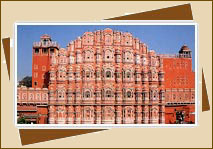 The
old Jaipur painted in Pink can
grip any visitor with
admiration. Stunning backdrop of
ancient forts Nahargarh, Amer,
Jagarh and Moti Dungri are
dramatic testimonials of the
bygone era and a reminder of
their lingering romance. The
old Jaipur painted in Pink can
grip any visitor with
admiration. Stunning backdrop of
ancient forts Nahargarh, Amer,
Jagarh and Moti Dungri are
dramatic testimonials of the
bygone era and a reminder of
their lingering romance.
Settled in the rugged hills of
the Aravallis, Jaipur is the
pristine jewel in the desert
sands of Rajasthan. Jaipur is as
remarkable for its marvellous
architecture and town planning
as it is for the lively spirit
of the people who inhabit it.
The city presents a unique
synthesis of culture that has to
be experienced in order to be
appreciated.
With its origin buried deep into
the pages of history, the city
still exudes a magical old world
charm; an aroma of chivalry and
romance is evident, despit
having evolved into a city that
is the hub of modern commercial
activity in the region.
Tell-tale signs of the glorious
past and regal splendour of the
city lie strewn across with gay
abandon.
The colourful and intricately
carved monuments are adequately
matched by the lively spirit of
fanfare, festivity and
celebration of the people. Even
today, one can find weather
beaten faces with huge coloufrul
trurbans, fierce moustaches and
lips that spontaneouslya crease
into a heart warming smile.
A city like Jaipur, where
modernity and tradition live
hand-in-hand, is truly rare.
Perhaps this is what makes it an
attractive destination for
tourists who flock to Jaipur ,
year after year. Jaipur is named
after its founder the warrior
and astronomer sovereign Sawai
Jai Singh II (ruled 1688 to
1744).
The decision to move out of his
hilltop capital Amer was also
compelled by reasons of growing
population and paucity of water.
Moreover in the early seventh
century the power of the great
Mughals was dwindling with its
aging Monarch Aurangzeb and
after several centuries of
invasions the north was now
quite and the wealth of the
kingdom had become greater than
before.
Seizing upon this opportune time
Jai Singh planned his new
capital in the planes. Jaipur is
a corroborative effort of Sawai
Jai Singh's strong grounding in
sciences and astrology and a
Bengali architect Vidyadhar with
a strong instinct for planning.
Places to see :
Forts & Palaces
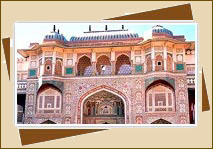
»
Amber Fort
At a short distance of 11 kms .
from Jaipur, the Amer Fort
complex stands amidst wooded
hills overlooking the Delhi-Jaipur
highway, with its forbidding
ramparts reflected in the still
waters of the Maota Lake below.
»
Jaigarh Fort
It is one of the few military
structures of medieval India
preserved almost intact,
containing palaces, agrdens open
and covered reservoirs, a
granary, an armoury, a
well-planned cannon foundry,
several temples, a tall tower
and a giant mounted acnnon-the
Jain Ban, the largest cannon in
the world.
»
Nahargarh Fort
Perched atop a pricturesque
hill, the Nahargarh Fort offers
a breathtaking view of the city
below. Initially built by Sawai
Jain Singh in 1734 A.D. It was
enlarged and given its present
shape by Sawai Madho Singh
in1885 A.D. Decorative motifs in
some of the rooms are
delightful.
»
City Palace
The City Palce is an imposing
blend of traditional Rajasthani
and Mughal art and architecture.
The City Palace complex houses
several palatial structures. The
first building in it is Mubarak
Mahal, built by Kaharaja Madho
Singh. It has a beautifully
carved marble gate with heavy
brass doors on either side of
this gate. Beyond this gate lies
the Diwan -e-Khas, or the "Hall
of Private Audience".
Monuments in Jaipur
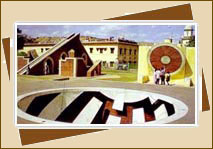
Jantar Mantar
Jantar Mantar is the most famous
and elaborate observatory of its
time. It was constructed in the
year 1724 A.D. by Sawai Jai
Singh II, even before the city
of Jaipur was built, and has
been described as the most
surrealistic and logical
landscape instone. It was built
to measure the local time, the
sun's declination, altitude, the
declination of stars, planets
and to determine eclipses.
Hawa Mahal
The Hawa Mahal, or the "Palace
of Wind" built by Maharaja Sawai
Pratap Singh in 1799 A.D. is
characterised by elaborate and
fanciful architecture. The broad
pyramidical facade comprises
five storeys of semi octagonal
overhanging windows with
perforated screens, domes and
spires.
Temples in Jaipur :
Govind Dev Ji Temple
A vital part of the city Palace
complex, this Krishna temple has
been highly preserved by the
erstwhile royal family. Sawai
Jai Singh installed the image of
GOVIND DEV JI(an incarnation of
lord Krishna) after it was
brought from Vrindavan. Housed
within the sanctum of this spire
less temple, the patron deity of
the royal family is very
religiously worshipped by most
of the Hindus in the city and
near by areas. The image is
unveiled seven times daily for 'AARTIES'
and BHOGS offered in the silver
wares, consisting of sweets
mostly. The idols of RADHA
KRISHNA are dressed in different
styles each time for the 'AARTI'
procession where thousands of
followers or 'Bhakt' gather
around the courtyard for the
Darshan (a look connecting them
with the divine).
Birla Lakshmi-Narayan Temple
Birla Mandir or the Lakshmi -
Narayan Temple, situated just
below the Moti Dungari. This is
a modern temple built of white
marble on top of a hill,
dominating the skyline of south
Jaipur. The Birlas
(industrialists who have also
built several temples in India)
built this temple. The temple
has been constructed in white
marble and has three domes, each
portraying the different
approaches to religion. The
presiding deities here are
Vishnu (One of the Hindu Trilogy
Gods) called Narayan and his
consort Lakshmi Goddess of
wealth and good fortune. The
temple is built is white in
marble and exterior has carved
sculptures of various
mythological themes and images
of saints. The interior has
large panel in marble of
mythological proceedings. The
images of the deities are placed
in the sanctum sanctorum. Built
on raised ground, it is
surrounded by large lush green
gardens.
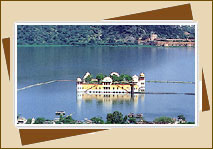 Moti
Dungri (Ganesh Temple) Moti
Dungri (Ganesh Temple)
In the middle of Jaipur rises a
small hill Moti Dungri meaning
pearl hill, because it looks
hill a drop of pearl. An exotic
palace is parched which is a
replica of Scottish castle once
occupied by Maharaja Madho
Singh's son. From There on
remained as a private property
of the ruling family. In the
recent past it served as a home
for Rajmata Gaytri Devi and her
estranged son Jagat Singh. The
mere view of this castle is
exotic enough. The highlight of
this place is the famous and
auspicious temple of Lord Ganesh,
which is frequently visited by
almost whole of Jaipur and
people from outside.
Jagat Shiromani Temple
The beautifully carved Jagat
Shiromani Temple houses the idol
of Lord Krishna and is popularly
associated with the celebrated
saint-poetess Mira Bai. The old
temple of Narsinghji and a step
well Panna Main-ki-Baodi, which
still bears witness to its past
glory are also located in the
vicinity.
Exursions in Jaipur :
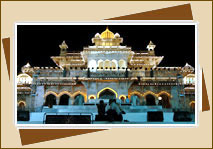 Tonk
and the persian art Tonk
and the persian art
It is located, 96 kms away from
Jaipur. This is a quiet town
which was ruled by tribes of 'Pathans'
from Afghanistan. The focal
point of Tonk is the Suneri
Kothi, the Golden Bungalow. A
fairly ordinary monument from
outside, it has stunningly rich
ornamental interiors. There are
also some interesting building
that accommodated the British
office. Tonk is also famous for
its leather and felt industry
and one can pick up a good
bargain from the markets. The
Nawab of Tonk was an avid book
lover and built a sizable
library of Arabic and Persian
manuscripts. Arabic and Persian
Research Institute are also
located here.
Sanganer
Sanganer is located 16 Kms from
Jaipur. It is also known for
exquisite Jain temples.
Moreover, it is an important
centre for crafts and
hand-printed textiles that is
internationally famous.The most
beautiful temple in Sanganer is
the ancient Shri Digamber Jain
temple. The temple has fine
carvings as those of the
magnificent Dilwara temples of
Mount Abu. Built in various
phases with sky-high shikharas
(spires), the temple represents
an old style of architecture.
The last phase was probably
built in the 10th century. The
beautiful nij-mandir (inner
temple) is a stone shrine with
three pinnacles. In the centre
is an idol of Parshwanath with 7
serpent hoods. All around it,
are carvings of lotuses,
creepers and elephants pouring
water from pitchers held in
their trunks. But the main idol
is that of Adinath, installed in
the shrine behind this.
The town is most famous for its
hand paper and mostly
screen-printed fabric. The
fabric is popular for small
floral designs. A wide variety
of material for apparels,
furnishing and curtaining is
available. Some of the
traditional designs were
produced in the patronage of the
royal family. It is a beautiful
sight to see brightly colour
fabric drying out in the sun
near the river.
Sawai Jai Singh II set up a
paper business in Sanganer on
the outskirts of Jaipur. It is
said that in the 16th century,
the ruler of Amber, Raja Man
Singh, brought Kagzis to
Sanganer (situated on the bank
of Saraswati River, where
abundant clear water was
available). The town emerged as
one of the biggest paper making
centres in northern India. In
between, however the industry
did get a setback, but after
independence, the Khadi and
Village Industries Commission (KVIC)
included the handmade paper in
its agenda for promotion of
crafts.
It is famous for kagazi mohulla
(handmade paper) and block
printing and is the world's
largest centre of hand-made
paper. Sanganer is blessed with
water and open spaces, essential
for papermaking. From here the
Kagzis enjoyed patronage of the
royal court of Sawai Man Singh
and his successors. Today there
are about 10 hand-made paper
industries in Sanganer, all
owned by Kagzis. Of these the
largest is Salim Kagzi's
Handmade Paper and Board
Industries. All Sanganer paper
makers are the largest producers
of hand-made paper in the world.
The airport of Jaipur is also
located in Sanganer.
Bagru
It is located 30 kms away from
Jaipur on the Ajmer Road and is
well known for its Bagru prints.
This technique simulates a
wooden block on which the
required design is first carved,
then the carved block is used
for transferring the motif in
the desired colour on the
fabric. This process is most
effective on ethnic floral
patterns and for printing in
vegetable dyes in traditional
Bagru Prints.
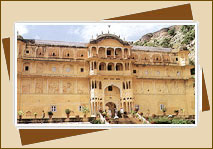
Samode
The fort is an old fortified
residence of the Nathawat family
(hailing from chomu) that served
as the Prime Ministers of the
Jaipur Royal Court is located
some 40km from Jaipur and 264 km
from Delhi in the range of
Aravali. This magnificent fort
is as charming and romantic in
itself, and exhibits grandeur,
good taste, class and elegance.
The way to the fort's main
entrance is through the inside
of the village, which can be
covered from the highway by a
camel safari, with the locals
welcoming the guests with smiles
and thrilling expressions. The
inside of the fort reflects
expressions of the medieval
architecture that is renovated a
bit for the oriental formality.
The open courtyards in the
centre has separate wings on the
sides that extends to 43
spacious rooms & suites having
private balconies and views. The
walls are in warm colours to
highlight the intricate marble
work, the antiques and the
colourful art with traditional
artefacts. The Durbar hall of
Samode Palace is one of the most
beautifully painted chambers
with glass & minakari work and
the same goes for the private
restricted spaces- meant for the
"zannanis", women of the family.
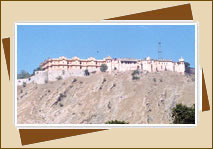 Sariska Sariska
This park
is situated only 200 km from
Delhi and 107 kms from Jaipur.
Although larger than Ranthambor,
it is less commercialised and
has less tigers but a similar
topography. It covers an area of
800 sq km in total, with a core
area of approximately 500 sq km.
The Northern Aravali Hills
dominate the skyline with their
mixture of sharp cliffs and long
narrow valleys. The area was
declared a sanctuary in 1955 and
became a National Park in 1979.
The landscape of Sariska
comprises of hills and narrow
valleys of the Aravali hill
range. The topography of Sariska
supports scrub-thorn arid
forests, dry deciduous forests,
rocks and grasses. The broad
range of wildlife here is a
wonderful example of ecological
adoption and tolerance, for the
climate here is variable as well
as erratic.
It is located in the
contemporary Alwar district and
is the legacy of the Maharajas
of Alwar. Pavilions and Temples
within Sariska are ruins that
hint at past riches and glory.
The nearby Kankwadi Fort has a
long and turbulent history.
In morning and evening, wildlife
in Sariska heads towards the
many water holes, which litter
the park, thus providing the
guests with their best chance of
viewing game. At some of these
watering holes it is possible to
book hides which are situated in
prime spots for wildlife
viewing.
Ranthambhor National Park
Ranthambhor National Park,
before a princely game conserve
is the scene where the
celebrated Indian Tiger is best
seen. Ranthambhor Tiger Reserve
lies on the junction of Aravali
and Vindhyas just 14 Kms from
Sawai Madhopur in Eastern
Rajasthan. It sprawls over a
varying and undulating
landscape. The scenery changes
dramatically from gentle and
steep slopes of the Vindhyas and
sharp and conical hills of the
Aravali. A tenth century fort
also blends amicably with the
background. Pure sands of Dhok (Anogeissus
pendula) interspersed with
grasslands at the plateaus,
meadows in valleys and luxuriant
foliage around the canals make
the jungle. Three big lakes –
Padam Talab (meaning Lake),
Malik Talab and Raj Bagh – are
similar turquoises studded in
the vast forest that abounds
with aquatic vegetation
including duckweeds, lilies and
lotus.
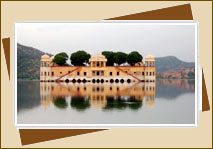 A
significant geological feature
within the park is the 'Great
Boundary Fault' where the
Vindhaya plateau meets the
Aravali range. The Rivers
Chambal in the South and the
Banas in the North bound the
National Park. The park is
dotted with steep rocky hills
and the dominating architecture
of Ranthambhor Fort (built in
the 10th century), adds to its
landscape. The rugged park
terrain alternates between dry
deciduous forest, open grassy
meadow, dotted by several lakes
and rivers that are only made
passable by rough roads built
and maintained by the Forest
Service. A
significant geological feature
within the park is the 'Great
Boundary Fault' where the
Vindhaya plateau meets the
Aravali range. The Rivers
Chambal in the South and the
Banas in the North bound the
National Park. The park is
dotted with steep rocky hills
and the dominating architecture
of Ranthambhor Fort (built in
the 10th century), adds to its
landscape. The rugged park
terrain alternates between dry
deciduous forest, open grassy
meadow, dotted by several lakes
and rivers that are only made
passable by rough roads built
and maintained by the Forest
Service.
The tiger is not the only
attraction at Ranthambhor;
although it is the one park
resident that people come to
see. A variety of birds
including Owlets, the ubiquitous
Langur (monkey), Leopard,
Caracal, Hyena, Jackal, Jungle
Cat, marsh Crocodiles, Wild
Boar, Bears and various species
of Deer are the other
attractions.
Abhaneri
Abhaneri is a village about 95
kms from Jaipur on the Jaipur-Agra
Road. A detour is well merited
for its amazing step wells or 'baoris'
and Harshat Mata Temple.
According to a legend, the
village is so called because the
Goddess Harshat Mata who is
shown portrayed in a joyous mood
is believed to spread brightness
or "abha" all around. The
village's original name was Abha
Nagri, and its name today is
Abhaneri.
It is believed that the
celebrated king Raja Chand
established the village. On the
other hand it is felt that the
mythological Raja Chand could be
King Bhoja, who ruled over the
Gurjar kingdom in the ninth
century AD. The ruins of the
temple also speaks of the 10th
century architectural and
sculptural styles. There is a
huge tank named "Chand Baori",
opposite to the temple fortified
on all four sides with bastions
for defence. Even though
Abhaneri is now in ruins, the
place has a distinct
reminiscence about itself. It is
best approached by road, buses
ply between Jaipur and Agra.
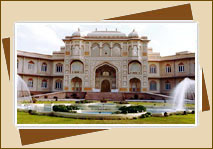
Kaurali
Located at
182 kms southwest of Jaipur, it
was founded in 1348 and is best
known for its Krishna Temples.
The Fort, which was constructed
over different period, is about
600 years old. The fort was the
residence for the royal family
until 1950 and is now occupied
by monkeys and geese. The geese
were used in the early days as
warning system against any
intruders. They still seem to be
doing their duty. The Bhawar
Vilas Palace, which is owned by
the descendents of the royal
family and resembles a large
manor, is a hotel now. The rooms
are comfortable and good meals
are available. Karauli is best
connected by bus or taxi from
Jaipur.
How to Reach Jaipur
Jaipur is 262 kms. from Delhi,
and is well connected by road,
rail and air from all over the
country. There is also a special
luxury train, the Palace on
wheels,which starts from Delhi
every Wednesday from September
to April, on a round trip of
Rajasthan, the first stop being
Jaipur. Regular luxury buses are
available round the clock and
speical trains like the Shatabdi
Express and Intercity Express
ply regulary.
Air:
The Jaipur Airport is called
Sanganer Airport . There are
domestic flight connections to
Delhi, Kolkata, Mumbai,
Ahmedabad, Jodhpur and Udaipur.
There is a single international
flight to Dubai.
Train:
Connections are from Delhi,
Agra, Mumbai ,Chennai, Bikaner,
Jodhpur, Udaipur, Ahmedabad.
Well connected from other states
like UP, MP .
Road:
A convenient mode of travel to
Jaipur is by road. Regular bus
service of AC and Deluxe Coaches
are available.
|